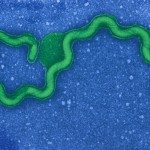Lien vers Pubmed [PMID] – 25987703
Infect. Immun. 2015 Aug;83(8):3061-73
Leptospirosis is a life-threatening and emerging zoonotic disease with a worldwide annual occurrence of more than 1 million cases. Leptospirosis is caused by spirochetes belonging to the genus Leptospira. The mechanisms of disease manifestation in the host remain elusive, and the roles of leptospiral exoproteins in these processes have yet to be determined. Our aim in this study was to assess the composition and quantity of exoproteins of pathogenic Leptospira interrogans and to construe how these proteins contribute to disease pathogenesis. Label-free quantitative mass spectrometry of proteins obtained from Leptospira spirochetes cultured in vitro under conditions mimicking infection identified 325 exoproteins. The majority of these proteins are conserved in the nonpathogenic species Leptospira biflexa, and proteins involved in metabolism and energy-generating functions were overrepresented and displayed the highest relative abundance in culture supernatants. Conversely, proteins of unknown function, which represent the majority of pathogen-specific proteins (presumably involved in virulence mechanisms), were underrepresented. Characterization of various L. interrogans exoprotein mutants in the animal infection model revealed host mortality rates similar to those of hosts infected with wild-type L. interrogans. Collectively, these results indicate that pathogenic Leptospira exoproteins primarily function in heterotrophic processes (the processes by which organisms utilize organic substances as nutrient sources) to maintain the saprophytic lifestyle rather than the virulence of the bacteria. The underrepresentation of proteins homologous to known virulence factors, such as toxins and effectors in the exoproteome, also suggests that disease manifesting from Leptospira infection is likely caused by a combination of the primary and potentially moonlight functioning of exoproteins.

